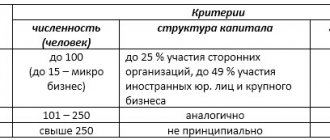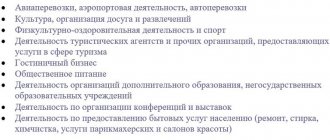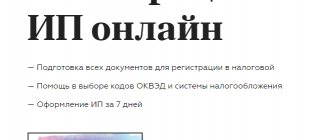Igor Berezin Partner of the consulting company Semperia M&S () President of the Guild of Marketers () Member of the Board of Directors of the research holding Romir (8-903-788-3343)
The objective of the proposed article is to separate medium-sized businesses from large, on the one hand, and small, on the other; and the beginning of a discussion on the issues of qualitative characteristics and quantitative assessments of medium-sized companies.
For some reason, in Russia it is not particularly customary to talk about medium-sized businesses as an independent subject of economic relations. Such linguistic constructions as “small and medium-sized businesses” and “large and medium-sized enterprises” are in use. Moreover, note that in both cases, medium-sized businesses find themselves somewhere deep in second place, as if “in addition” to either hundreds of thousands of small businesses, or simply hundreds of largest companies, which account for half of the country’s gross product. Neither the criteria for classifying a medium-sized business nor its qualitative difference from large and small businesses have been defined. It seems that the average business is not very interesting in itself. This is quite strange, because even if we assume that large businesses actually account for about 50% of the gross production of goods and services in the country, and small businesses account for 15%, it turns out that a third of all goods and services are produced by medium-sized companies .
Number of employees
Probably the first sign that comes to mind when talking about the size of a company is the number of employees employed in it. Of course, this criterion is very relative and highly differentiated depending on the company’s membership in a specific industry. For example, a company with 60 consultants out of a total workforce of 120 makes it quite large in its industry. Most likely, such a company can claim to be among the 20-30 largest companies in this industry. The presence of 60 teachers at a university with a total number of employees of 120 people does not make it even medium in size. It is clear that in this case we are dealing with a small, most likely non-state educational institution of a narrow profile. Table 1 provides very rough boundaries for small, medium and large business sizes for ten different industries.
It is worth noting that the boundaries of small businesses based on the number of employed workers for individual industries are determined by law. This was done for the purposes of applying a simplified reporting and taxation system. They range across various industries from 15 to 200 people.
The boundaries of large business have never been clearly defined, but intuitively everyone understands that if we are talking about a truly large business, then the number of people employed in it can be thousands and tens of thousands of people, and in the largest, such as Russian Railways, RAO UES or Gazprom “—hundreds of thousands of workers.
So it is not possible to clearly define the boundaries of a medium-sized business in terms of the number of employees. In the most general approximation, we can talk about boundaries between several tens and several thousand people.
General partnership
A collective business, under the terms of which all participants (owners) are endowed with equal rights and responsibilities, can be called a full partnership. With this form, it is possible to declare a large authorized capital and distribute responsibilities equally to everyone.
However, there is a risk of disagreement based on different financial viability. Not every participant is able to make a significant tranche into the authorized capital. Disputes are also possible at the time of making important decisions, if there are excellent contributions to the development and activities of the company.
Turnover
In terms of turnover, it is no less difficult to separate medium-sized companies from large and small ones. There are also very significant industry specifics here. A research company with a turnover of 10-12 million dollars in 2006 can be congratulated - it is one of the five largest in our market, controlling a share of approximately 6% of this market nationwide. A food chain (of 11 stores) with such a turnover is a microscopic player even in the food market of one large city such as Omsk or Yekaterinburg, whose share does not exceed 1% of the city retail market; this is one of the first candidates for takeover or departure from the market.
Nevertheless, the turnover criterion is very important, and it is not possible to ignore it. So. In 2005, companies whose turnover exceeded $150 million could rightfully claim to be included in the ratings of the 200-400-800 largest according to various versions: RA Expert, Interfax, Kommersant Publishing House, RBC . This is the conventional boundary of big business.
On the other side. Today (since January 1, 2006), companies whose turnover does not exceed 15 million rubles can apply for a simplified reporting and taxation system. This is 557 thousand dollars at the 2006 exchange rate. Representatives of small businesses themselves are asking to increase the “simplification limit” to 60 million rubles ($2.23 million). This figure can very roughly be considered the boundary separating small and medium-sized businesses. Of course, the boundaries turned out to be very extensive - two orders of magnitude, as well as in terms of the number of employees.
It’s probably time to draw internal boundaries in medium-sized businesses, just as it was done at one time when analyzing the Russian middle class. We will consider “MEDIUM-large” a business with a turnover of 50 to 150 million dollars per year; “MEDIUM” - with a turnover of 12 to 50 million per year, or from one to four million dollars per month; and “MEDIUM-Small” with a turnover of 2.5 to 12 million dollars per year.
Small business - from 0.5 to 2.5 million dollars. annual turnover. Less than $500 thousand annual turnover is a “micro-business.”
Business in crisis due to the desire to save money
During a crisis, people strive to save on almost everything, so second-hand stores, consignment stores, children's consignment stores, fixed-price stores and similar drogerries, which rely on goods with a long shelf life, become relevant. Most business ideas that can be launched in residential areas are designed for economy class.
Another angle on the same topic is the desire of existing businesses to optimize business processes, to replace workers with automated systems and cloud services.
Market share
Another possible approach to dividing companies into large, medium and small is based on the market share they occupy. For example, companies whose market share exceeds 5% will be considered large; those whose market share is less than 0.5% are small, and companies with a market share of 0.5 to 5% are medium. Again, three groups can be distinguished: “MEDIUM-small” - 0.5-1%, “MEDIUM” - 1-2.4%, “MEDIUM-large” - 2.5-5% of the market.
This approach will allow us to solve the problem of incomparability between different industries in terms of total sales volume and number of employees. After all, we operate with relative indicators. And our research company with a turnover of 10-12 million dollars per year - “MEDIUM-small” by the turnover criterion becomes “large” by the criterion of a market share of 5-6%.
But here another problem arises - different markets have different degrees of concentration. In some (juices, beer, mobile communications, etc.) three to five largest players already control 75-85% of the turnover. In others (book publishing, dumplings, ice cream, etc.), hundreds, if not thousands of small players still account for about 50% of the market. But we are not looking for one universal criterion for classification at all times.
Company management structure
Companies in which all employees report directly to the CEO (who, as a rule, is the owner or co-owner of this business) obviously belong to the micro-level of business. The maximum number of employees that one such manager can keep under direct and immediate subordination, as a rule, does not exceed 15-25 people.
Companies in which there is only one managerial link between senior managers and ordinary employees are most likely small businesses. Of course, there are probably exceptions to this rule, due to the same industry specifics. But somehow they don’t immediately come to mind. Moreover, the maximum number of employees in a company with one management level cannot exceed 150 people (provided that the effectiveness of this management is maintained). And 150 people is by no means a big business.
Companies with 2-4 management levels can be considered medium. Here it is no longer possible to say with certainty that 4 links are “MEDIUM-large”, and two are “MEDIUM-small”. There is a high level of industry and individual specificity - some bosses come from paramilitary structures and like to build management pyramids of four floors with 500 employees, others have read fashionable books and are trying to “roll” five thousand people into a two-tier structure. But, I believe, in the sense of Pareto’s Law, this rule may well work on large samples.
Of course, during the period of increasing fashion for “flat” management pyramids, there were attempts in very large companies to build a management structure of 3-4 links. But, as far as I know, they quickly ended in fiasco, and the number of management levels again increased to 5-7 levels, which is the optimum (but by no means the maximum) for really large companies.
Marketing function
In a small business, marketing issues (and sometimes even sales in general) are dealt with by the head (and owner) of the company himself. The maximum that he can afford is an assistant who, in addition to marketing issues, will deal with a bunch of different other tasks.
In an average business, marketing issues should be handled by at least one specialist specially designated for this purpose - a “marketing manager”, and, at most, a department of 2-8 employees. In this case, a separate service or department deals with sales issues.
A large business should have a "marketing department" headed by a director or vice president in charge of these matters. This division can be called anything:
- “service/department/department/marketing group”;
- "planning and Economic Department";
- “strategic planning department”;
- “Advertising and PR Department”;
- etc.
The point is not in the name, but in the fact that in the structure of this division there should be departments or groups of 2-8 employees responsible for individual areas of marketing work: consumer and competitor research, analysis and
planning, trademark management (brand management), sales promotion and promotion, advertising and PR.
Of course, how it “should be” and how it “really is” are two big differences (as they say in Odessa). Today it is not uncommon for a large Russian company to not have even one marketing manager or brand manager. But is this right? And how long will this situation persist?
Today, the information that we (marketers, analysts) receive from the market indicates that more and more companies are either starting to switch to regular (and correct!) marketing and management, or are leaving the market.
Public/religious organizations
These companies are characterized as non-profit. They are allowed to engage in business only for the purpose of their establishment. All property that comes into the possession of communities ceases to be the property of the donor.
These enterprises can be:
- fund
- movement or organization
- political party
- institution
They are created for public needs. Religious communities are based on religion.
Between large and small: according to the “magic of numbers”
So, in the country there are several hundred (up to 1000) very large companies: with a turnover of 150 million dollars a year and above, with an average number of employees of 25 thousand people per company.
There are still several million (two or three) small businesses with an annual turnover of no more than 2.5 million dollars, with an average number of employees of 5-7 people.
“The music of numbers” suggests that there should be 3-5 thousand “MEDIUM-large” companies in Russia, 10-25 thousand “MEDIUM” companies, 30-150 thousand “MEDIUM-small” companies. However, these arguments are very approximate and are not substantiated by anything other than the “beauty of the numbers.”
Between large and small: by number of employees
About 70 million people are actually employed in the country's economy today. Incl. about 15-20 million work in those same 500-1000 largest companies, which supposedly account for 50-60% of the production of goods and services in the country. Another 10-15 million are in small businesses. 5-10 million are “self-employed” and “not-clear-how-employed”. What remains is 25-35 million people (from a third to a half of the economically active population) who should be employed in medium-sized businesses.
We have not yet been able to determine the size of the average headcount of a medium-sized company. In the very first and very rough approximation, it can range from 250 to 1000 people. Based on these considerations, it turns out that there are from 25 to 160 thousand medium-sized companies in our country.
By the way, here’s another interesting fact: 80-100 thousand companies regularly submit profit and loss reports to the Federal Statistics Service. This does not take into account small businesses, banks and insurance companies, federal state unitary enterprises and enterprises of the education and healthcare systems. Of course, some of the companies that submit reports to the FSGS are small, according to our classification. But there are also medium-sized companies that do not provide their statistics, although this is a violation. But in general, the order of the numbers is still consistent.
Franchising as a form of organization
This form provides for the sale of rights to use a brand or service delivery system of a ready-made and operating enterprise. The seller is the franchisor, the right to use is the franchise, the buyer is the franchisee.
Franchising is used in a wide variety of business areas. Particularly popular in the following industries:
car service and auto industry- consulting, marketing, accounting
- construction and renovation of houses
- educational programs
- tourism
- restaurants and other catering facilities
- retail
- health and beauty services
By leasing the rights to a business, the franchisor issues instructions for creating and running a business, opening an office or point of sale, and sets quality standards. But in fact, part of the control over the new office/outlet is lost, since franchisees work more independently. They have their own legal entity. face, accounting, personnel, etc.
Franchisees pay a set commission on revenue or a standardized monthly fee for using the name and other developments.
In Russia, over the past few years, this form of organization has been gaining popularity among businessmen.
Between large and small: by turnover and share in SOP
In the business media, it is customary to calculate the total share of large (or small) companies in the Gross Product (GDP). However, this approach is not correct, because There is a problem of re-counting. Here's a simple example. Let’s say Rubin produced a million televisions and sold them at $175 apiece to one retail chain (let it be M.video). Revenue was $175 million. Big company? Undoubtedly! This retail chain sold these million televisions for $275 each. Revenue was $275 million. Big company? Certainly! The combined turnover of these two large companies is $450 million, but their contribution to GDP is only $275 million. So it is necessary to compare the total turnover of companies of various sizes not with GDP, but with the Total Social Product (SOP). Nowadays, this indicator is practically no longer used, but in Soviet statistics it was one of the key ones.
A very rough and approximate estimate of the SOP in 2006 is $1,600 billion. Russia's GDP in 2006 was about $980 billion. Table 2 shows the possible contribution of companies of different sizes to the SOP in 2006. The data is very, very approximate. They were obtained analytically.
As follows from the table above, we have about 50 thousand medium-sized companies in Russia, and the majority are “MEDIUM-small”, with a turnover of 2.5 to 12 million dollars per year. And they account for almost half of the SOP produced in the country (and, by the way, GDP).
Municipal/unitary enterprises
Unitary companies do not have ownership rights to property transferred to them by the owner. Thus, these companies are only objects and not subjects of ownership.
There are municipal (MUP) and state-owned (SUE) enterprises. They manage the acquired property in two formats, based on the right:
- economic control
- operational management
Household management creates significant economic opportunities (freedom) for the company - its work under the control of authorities and municipal organizations is not as limited as under the control of state-owned enterprises (more details in the table).
Table 1. Comparison of unitary firms in the Russian Federation.
| Types of unitary organizations | Description | ||
| Company liability | Possibility of selling property | Authorized fund | |
| As an owner control | The owner is not liable for the company's debts | The company has the right to manage its assets, in addition to real estate | State unitary enterprises have more than 5,000 minimum wages; for municipal unitary enterprises - no less than 1,000 minimum wages |
| Operational management (state-owned companies) | Vicarious liability for the organization’s obligations is assigned to the owner | You can only sell company products | Not created |
The Law on Unitary Legal Entities additionally includes a condition for providing information about their procurements on government websites. regional procurement, and for municipal ones - on the official pages of the municipal unitary enterprise.
Changes in the work of municipal unitary enterprises and state unitary enterprises on video:
By activity in the field of marketing communications
According to the survey “On the state and prospects for the development of the market for marketing services in Russia,” conducted by the Guild of Marketers in 2006, the total volume of orders received by research companies for conducting quantitative market research in 2006 amounted to $135 million, qualitative research - 50 million dollars. The average cost of a quantitative study (according to expert estimates) is about $15 thousand, and a qualitative one is $7-10 thousand. Thus, in 2006, about 14-16 thousand studies (research projects) were carried out on orders from Russian and Western companies. Let’s say three thousand studies (no more) were carried out at the request of Western clients. Another 2-3 thousand were ordered by large Russian companies, each of which ordered 2-3 studies per year, on average. This means that 8-11 thousand studies were carried out at the request of Russian medium-sized companies.
Of course, not all medium-sized companies annually need to conduct research by external research structures. Not everyone who is in need understands this. Not all of those who understand the need to order research can pay for it (or mistakenly think that they cannot afford it). But, even if we assume that only a quarter of medium-sized companies order research, it turns out that there are from 32 to 44 thousand such companies in Russia.
According to the same survey, in 2006, 4-5 thousand companies used the services of direct marketing agencies. And the services of BTL agencies - 10-12 thousand companies. These numbers are very close to our assessment of "AVERAGE" companies.
Business in a food crisis
Continuing the theme that people will always eat, we would like to highlight a category that includes all other areas related to the production, storage and delivery of food. In 2020, food of daily demand, baked goods (everything about opening a bakery is here), cheap alcohol, and soft drinks will be in demand.
Due to the closure of most restaurants and cafes (although this is temporary), the sale of street food has become more relevant - street food and, of course, food delivery services (more on this below). Also, while restaurants and cafes are closed, vending, in particular, the sale of coffee through vending machines, may be relevant.
For public catering, one of the few sales channels today is home delivery of food with a connection to aggregator services. Meal subscription services can also be arranged.
- Find out if a subscription model is right for your business?
In many ways, household services for the repair of refrigerators and freezers can be called an anti-crisis area. As a rule, people do not put off such a breakdown for long.
Upon passing ISO
According to the All-Russian Quality Organization, by mid-2005, five thousand Russian companies were certified according to ISO standards. Of course, not all medium-sized companies require such certification. Not everyone who needs it understands this. Not all of those who understand the need to obtain ISO have the money and organizational resources to undergo this certification. It can be assumed that of all medium-sized companies, only 10 or 15% have passed such certification. Then the total number of medium-sized companies can again be estimated at 30-50 thousand.
Business in crisis. Toys for adults
Speaking of toys. They are needed not only for children. Sales of adult toys are growing significantly during self-isolation. For example, the Womanizer brand announced an unplanned 50% increase in sales of sex toys.
Due to the fact that people began to spend more time at home, they began to need to diversify their leisure time. Russian market participants also report an increase in sales of condoms, massagers, lubricants and suits. A threefold increase in sales of goods for adults compared to the annual average was recorded by the Ozon store.











